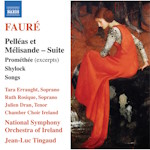
Johann Sebastian Bach (1685-1750)
The Art of the Fugue BWV 1080 (1745-1746?)
(reconstruction of Fuga a 3 soggetti Kees van Houten)
Choral “Wenn wir in höchsten Nöten sein” BWV 668a
Albert Cano Smit (piano)
rec. 2024, Auditorium Ansermet de l’École des Musiques Actuelles, Geneva, Switzerland
Aparté AP375 [80]
While I am a devotee of Bach’s later contrapuntal masterpieces such as the Goldberg Variations and Part Two of The Well-Tempered Clavier, I have always struggled somewhat with a proper appreciation of the Art of the Fugue (probably not the title Bach gave it, by the way; he simply referred to each piece as a “contrapunctus”). Like many a collector, my introduction to it was the instrumental arrangement made by Neville Marriner and Andrew Davis recorded by Philips back in the 1970s, and that was my sole exposure to the work until I acquired Grigory Sokolov’s account on the Naïve. I have revisited those two recordings a few times and come away respectful of its genius, especially when enlightened by musicologists regarding the hidden complexities of features such as its mirror fugues and counterfugues, but have never developed much affection for it, finding it quite abstruse and academic – whereas I am captivated from beginning to end by the Goldbergs. When I saw this new recording I was intrigued, and wondered whether hearing it again on solo keyboard – albeit a modern piano rather than Bach’s clavichord or harpsichord – would further enhance my enjoyment of it.
Pianist Albert Cano Smit, Swiss-born, of Spanish-Dutch parentage and currently residing in America, refutes the theory that The Art of the Fugue is a theoretical, instructive work for pedagogical purposes and is “certain that this is a piece that needs to and was meant to be performed and brought to life.”
All of which is a preamble to the clincher: really odd sound. The moment I first played this I was taken aback: present are a faint ambient hiss and rumble that I do not associate with modern digital engineering, then a strangely woolly, boomy piano tone making the instrument sound quite distant and as if heard through a wad of foam; higher, louder notes sound fuzzy, virtually distorted. To test whether my ears or playback equipment had suddenly stopped functioning properly, I compared this with a couple of recent recordings of the Goldbergs and soon had no doubt; something is wrong here – unless I had a dud pressing. I duly checked with the label and received this reply from their sound engineers:
“The sound on this record might sound not [to] be very accurate, but that’s not a technical error, it’s more an aesthetic choice made by the sound engineer and validated by the pianist.”
I can only say that I am puzzled by that choice and think it a great pity, as I can hear that Smit’s playing is sensitive, nuanced and energised when necessary. His touch is fleet and delicate, then percussive and emphatic by turns; for all I know this account might well have afforded me an unexpected pleasure – but I cannot get past the unpleasant “sound barrier”. You may feel differently; I suggest sampling it on the Presto website.
Ralph Moore
Buying this recording via a link below generates revenue for MWI, which helps the site remain free.



















